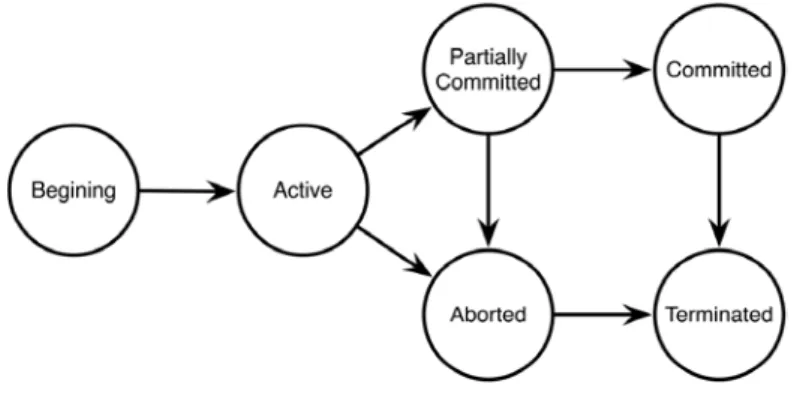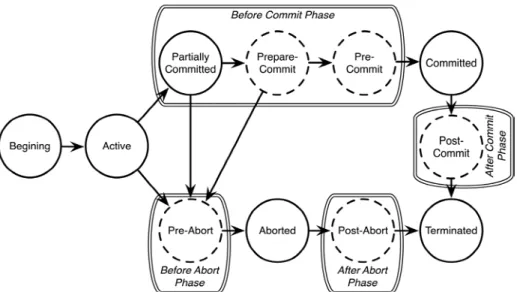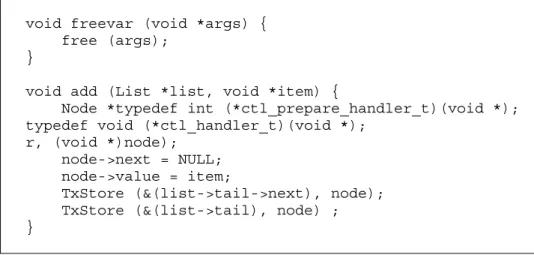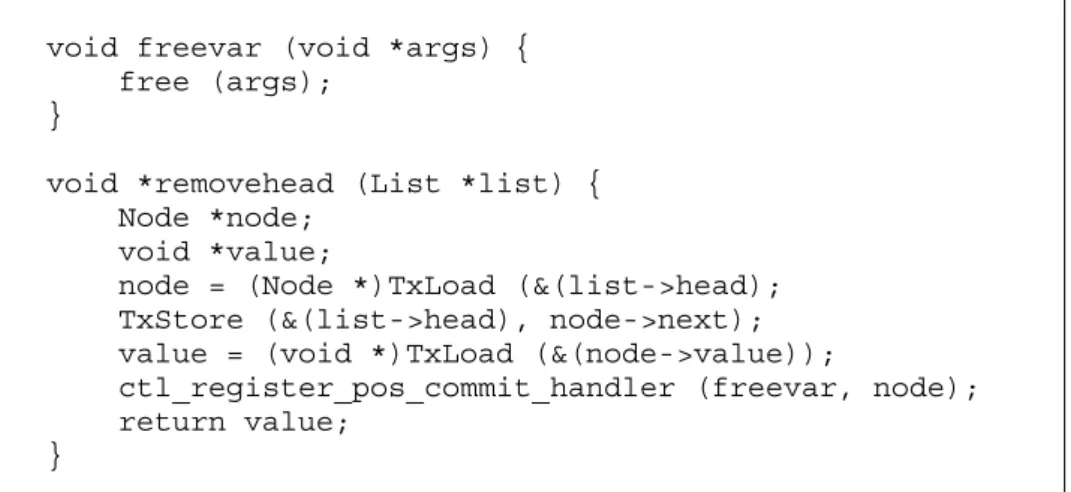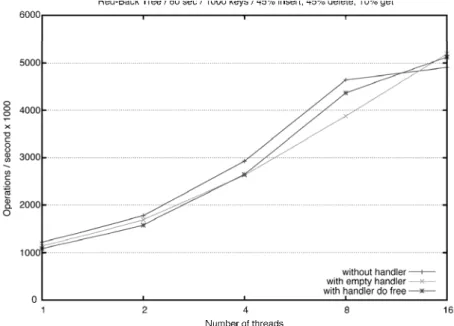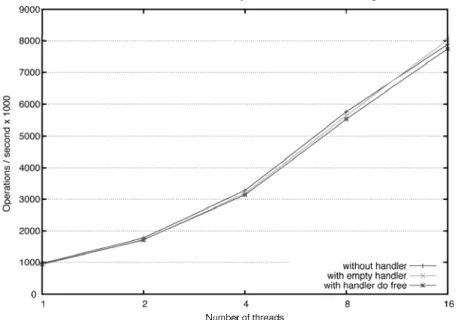Developing Libraries Using
Software Transactional Memory
Ricardo Dias1, João Lourenço1 and Gonçalo Cunha1 1CITI–Centre for Informatics and Information Technology, andDepartamento de Informática, Universidade Nova de Lisboa Portugal
{rjfd, joao.lourenco}@di.fct.unl.pt goncalo.cunha@gmail.com
Abstract. Software transactional memory is a promising programming model that adapts many concepts borrowed from the databases world to control concurrent accesses to main memory (RAM). This paper dis-cusses how to support revertible operations, such as memory allocation and release, within software libraries that will be used in software mem-ory transactional contexts. The proposal is based in the extension of the transaction life cycle state diagram with new states associated to the execution of user-defined handlers. The proposed approach is evalu-ated in terms of functionality and performance by way of a use case study and performance tests. Results demonstrate that the proposal and its current implementation are flexible, generic and efficient.
Keywords: Transactions; Software Transactional Memory; Compensa-tion AcCompensa-tions; Revertible OperaCompensa-tions.
1. Introduction
The current trend of having multiple cores in a single CPU chip is leading to a situation that many would believe absurd not long ago: one may have more computational processing power than can (easily) be used. To invert such a situation, there is the need to find and explore concurrency where before se-quential code would be written. An appealing approach towards such a goal is the transactional programming model, which makes use of high-level con-structs to deal with concurrency and is becoming a potential alternative to the classical lock based constructs such as mutexes and semaphores.
Since the introduction of Software Transactional Memory (STM) [1], this topic has received a strong interest by the scientific community. Opposed to the pessimistic approach used in lock-based constructs, transactional memory may use optimistic methods for concurrency control, stimulating and enhanc-ing concurrency. The need for performance has already made some authors propose to drop some interesting features. Early STM frameworks [2, 3] were implemented using non-blocking synchronization [4] and, as a consequence, they supported arbitrary thread failures. Tests with lock based STM
ComSIS Vol. 5, No. 2, December 2008 104
works [5, 6] suggest that this approach exhibits better performance and should be considered as an implementation alternative.
Until now, most STM implementations reside mainly in software libraries (e.g., for C or Java programs) with minimal or no changes at all to the syntax and semantics of the programming language, therefore relying in the pro-grammer to do the transactional memory accesses by way of a library API. Ongoing research is using Concurrent Haskell and Java as a test bed for run-time and compiler changes tosupport STM [2, 7]. Many problems and difficul-ties still persist in using the STM programming model, supported only by soft-ware libraries [8] or directly by thecompiler [9].
This paper discusses some of the problems related to using external librar-ies in a transactional context. The case study arose when developing small applications examples for the CTL [10] transactional memory library. CTL is a library-based STM implementation for the C programming language, derived from the TL2 [5] library. CTL extends the TL2 framework with a large set of new features and optimizations, and also solves some bugs identified in the original framework [11].
The remaining of this paper is organized as follows: Sect. 2 describes the motivation and context for this work; Sect. 3 proposes an approach to over-come the identified difficulties; Sect. 4 describes its implementation; Sect. 5 introduces some use case examples; Sect. 6 evaluates the overhead intro-duced by the current implementation; Sect. 7 discusses the related work; and Sect. 8 presents some concluding remarks, and some current and future re-search work within this topic.
2. Motivation
Programming using the STM model is straight forward: if one plans to do a set of memory operations atomically—do all or none of the operations—and/or want to access memory locations in isolation—the memory accesses will not interfere with concurrent accesses from other control flows (threads)—, such set of memory operations should be enclosed within a memory transaction. atomic{ operation_1; operation_2; ... operation_n; } start_T(); operation_1; operation_2; ... operation_n; end_T();
Fig. 1. Transactional code blocks supported by the programming language (on the left) or by a software library (on the right).
If the STM programming model is directly supported by programming lan-guage constructs, a transactional code block may look as illustrated in Fig. 1 on the left; while if the STM programming model is supported only by a soft-ware library, the same code block may look as illustrated in Fig. 1 on the right. Although syntactically different, both code blocks share a common semantic. The transactional model assumes that all the operations executed within a non-committed transaction can be undone. This is not always the case for memory transactions. The operations executed within a memory transaction will fall into one of two categories:
− Non-transactional operations. These operations are irreversible and cannot be undone. Examples include output to the terminal that has been read by the final user;
− Transactional operations. These operations can be undone and are safe to be used within memory transactions. Transactional operations may be sub-classified into one of three categories, according to how the transactional recovery is done:
− Pure transactional operations. Can be automatically reverted by the transactional memory run-time whenever necessary. Examples include read and write memory accesses;
− Revertible operations. Can be reverted or deferred by the transactional memory framework with the help of extra coding from a developer with some domain knowledge. Examples include explicit memory manage-ment operations (memory allocation and release);
− Compensable operations. Can be compensated with another operation in another transaction that produces an opposed effect. Examples in-clude truncating a file that was appended by a previously committed transaction. Compensable operations that are observed by entities ex-ternal to the system (e.g., users) become non-transactional.
When developing a software library, the library programmer (programmer from hereinafter) aims at creating a black box behind a well-defined interface (API), hiding all the implementation details from the library user (developer from hereinafter). Revertible operations, executed and compensated within the same transaction, have a full transactional behavior from the developer’s perspective and, therefore, should be available to and used freely by the pro-grammer.
The most appropriate time and location to revert any operation are, fre-quently, at the end of the transaction and when it finishes with either success or failure. If the operations to be reverted are executed inside a software li-brary, the transaction beginning and end are, most probably, outside the boundaries of the library itself. Thus, the programmer does not have access to those code points and cannot easily have the reverting operations be exe-cuted at the end of the transaction without violating the library abstraction and exposing the library internals to the developer.
Memory management operations (memory allocation and release), fall into the class of revertible operations. If the transaction aborts, the allocation of a memory block may be reverted by the release of that same memory block.
ComSIS Vol. 5, No. 2, December 2008 106
Reverting a memory release operation cannot always be achieved by allocat-ing a new identical memory block, as the contents of the initial memory block may have been permanently lost. A reasonable solution for this problem is to defer the memory release operation until there is a guarantee that the trans-action will commit and the free operation will not have to be reverted.
When and where to revert an operation, depends on the nature of the op-eration itself and on its usage context. As there is no general rule, we propose a solution that is both flexible and generic. Flexible because it can adapt to multiple needs/requirements by allowing to execute the reverting operations in a variety of well-defined steps in the transaction life-cycle; and generic be-cause it is not tied to any particular problem or solution model, and it can be used towards aims other than executing reverting operations.
3. Concept
and
Model
Memory transactions have a life cycle as depicted in Fig. 2. Once the transac-tion begins, it switches to the active state, where all the operatransac-tions will take place. When attempting to commit, the transaction switches to the partially
committed state and enters a validation phase, where all the operations
exe-cuted in the active state are validated to ensure the transactional properties such as atomicity and isolation. If the validation phase succeeds, the transac-tion will switch to the commit state, where all the operatransac-tion executed in the
active phase will be made effective and visible to other transactions and then
ends with a transition to the terminated state. If the transactional framework detects a violation of any of the transactional properties, either when execut-ing an operation or at the validation phase in partially committed state, the transaction must abort, thus switching to the aborted state. In this state, all the operations executed in the active state will be discarded/reverted by the transactional framework, and ends with a transition to the terminated state.
Fig. 2. Transaction life cycle state diagram.
Supporting revertible operations within transactions can be achieved by de-fining both, a reverting function (handler from herein after) and a point in the
transaction life cycle where that handler should be executed. We propose to extend the transaction life cycle with five new states associated to four impor-tant phases of the transaction life-cycle: before commit, after commit, before
abort, and after abort. These phases and their associated states are
illus-trated in Fig. 3. The new states are represented with a dashed line.
Fig. 3. Transaction life cycle state diagram with handler support
Each phase aggregates one or more states. In each of the new states, a set of user-defined handlers may be executed. Handlers must be registered after the beginning of the transaction and before its possible use. The handler lifetime is determined by its moment of registration until the transaction termi-nates. If the transaction is retried, handlers must be re-registered, thus there is no difference between the first execution of the transaction and its subse-quent retries.
Prepare-commit handlers are executed in the context of the transaction to
be committed and may force the transaction to abort. The memory validation step was done in the partially-committed state, thus prior to the before-commit
phase. Therefore, prepare-commit handlers execute knowing that the memory
transaction may commit. Each prepare commit handler returns a Boolean value: true meaning the transaction may proceed with commit, thus executing the next prepare-commit handler or switching to the pre-commit state; and false meaning the transaction must abort and, in this case, no more prepare-commit handlers will be executed and the transaction will switch to the pre-abort state.
Pre-commit handlers are also executed in the context of the transaction to
be committed, but knowing that the transaction will definitely commit. Thus, if at least one of the pre-commit handlers is executed, all of them will.
Post-commit handlers are executed after committing the transaction and,
ComSIS Vol. 5, No. 2, December 2008 108
Pre-abort handlers are executed just before aborting, thus in the context of
the transaction to be aborted. If the STM framework supports automatic retry-ing of aborted transactions, these handlers are executed just before retryretry-ing.
Post-abort handlers are executed right after aborting the transaction,
there-fore outside the scope of a transaction. If the STM framework supports auto-matic retrying of aborted transactions, these handlers will not be executed, as the transaction will switch back form the aborted state straight to the begin-ning. However, they will be executed if the user explicitly aborts the transac-tion.
All the handlers in the before-commit phase are executed under the as-sumption that the memory transaction will commit, i.e., while a transaction Ti executes the prepare-commit and the pre-commit handlers, no other transac-tion Tj conflicting with transaction Ti can force Ti to abort. This leads to a situa-tion where the code executed inside the prepare-commit and pre-commit handlers of Ti should never block the transaction, otherwise it may also block all the remaining Tj transactions conflicting with Ti or force them all to abort.
The adequate combination of prepare-commit and pre-commit handlers permit to execute a two-phase-commit protocol [12] between several transac-tional subsystems in which one of them is the memory transaction. As the name suggests, the two-phase-commit protocol includes two main phases: the preparation phase, where all transactions must first agree whether they will commit or abort; and the commit/abort phase, where all the transactions must perform the decision previously agreed. If the decision was to commit, the transaction manager will request that all the transactions commit. If the decision was to abort, the transaction manager will request that all the trans-actions abort.
Although both the pre-commit and the pre-abort handlers are executed within the context of the transaction, they cannot make use of transactional memory accesses. For pre-commit handlers, the memory transaction has al-ready been validated and any new transactional access to memory could re-quire new validations to be carried out. For pre-abort handlers, the transaction is potentially in an inconsistent state and no more transactional accesses to memory are allowed. Thus, the programmer must prevent and manage any potential data-races that may arise when processing/executing handlers.
4. Implementation
The model described in the previous section, was implemented as an exten-sion to CTL [10], a Software Transactional Memory library for the C program-ming language.
In CTL, each handler is identified as a function pointer that is registered in the software transactional memory handler subsystem. There are two differ-ent types of function pointers, as illustrated in Fig. 4.
typedef int (*ctl_prepare_handler_t)(void *); typedef void (*ctl_handler_t)(void *);
Fig. 4. Handler System API: handler functions types.
The type ctl_prepare_handler_t declares a pointer to a function to be executed as a prepare-commit handler. The type ctl_handler_t declares a pointer to a function to be executed as a pre-commit, post-commit, pre-abort, or post-abort handler.
Functions of type ctl_prepare_handler_t will return a boolean (true=1 or false=0) indicating, respectively, that the overall transaction can proceed or that it must abort. If and only if all of the prepare-commit handlers return true, the pre-commit handlers will be executed and the memory trans-action will commit, otherwise none of the pre-commit handlers will be exe-cuted and the transaction will execute the pre-abort handlers and abort.
When registering a handler, the programmer must provide an extra argu-ment with a pointer to a user-defined data structure. This data structure will later be given to the handler when (and if) it is executed. Following the C standard practice, if there is no need to pass data to the handler, the pointer may be initialized to NULL.
Each transaction has a list for each type of handlers. Each handler has an integer priority attribute, where smaller numbers correspond to a lower priority and bigger numbers correspond to a higher priority. The priority controls the order in which the handlers are executed. Handlers with higher priority are executed before handlers with a lower priority. Within the same priority, han-dlers are executed by registering order.
The API contains two functions for each type of handler: one requires the programmer to explicitly specify the priority attribute while the other does not, assuming a default priority. Figure 5 shows the registering functions for the
prepare-commit handlers. The user defined data structure is referenced by
the void *args pointer. The registering functions for the other classes of handlers are identical.
void ctl_register_prepare_handler_priority(
ctl_prepare_handler_t handler, void *args, int priority); void ctl_register_prepare_handler(
ctl_prepare_handler_t handler, void *args);
Fig. 5. Handler System API: prepare-commit handler registering functions.
Handlers are eliminated once the associated transaction commits or aborts. In CTL, transactions aborting due to a concurrency conflict are automatically restarted and no pos-abort handlers are executed. Post-abort handlers are
ComSIS Vol. 5, No. 2, December 2008 110
executed only for user-aborted transactions.
5. Using
the
Handlers
This Section will illustrate a case study—manipulating a linked list—, which makes use of the handler system just described to solve the problem intro-duced in Sect. 2, where the programmer needs to do some explicit memory management operations inside a library that will be executed in the context of a memory transaction.
When implementing the add operation for a linked list, there is the need to allocate memory to a new list node. If this memory allocation is executed in-side a memory transaction that aborts and is automatically restarted, a new list node will be allocated, and the previously allocated list node will be dan-gling and will originate a memory leak in the program.In the proposed model, the library developer could register a pre-abort handler that would free the memory just allocated if the transaction aborts.
Figure 6 illustrates the situation just described, registering a pre-abort han-dlerto revert the allocation of memory by releasing it. If the transaction aborts while adding a new node to a linked list, the handler will be executed and the memory released. Error processing, such as checking if the memory pointer is NULL, has been omitted for code simplicity.
void freevar (void *args) { free (args);
}
void add (List *list, void *item) {
Node *typedef int (*ctl_prepare_handler_t)(void *); typedef void (*ctl_handler_t)(void *);
r, (void *)node); node->next = NULL; node->value = item;
TxStore (&(list->tail->next), node); TxStore (&(list->tail), node) ; }
Fig. 6. Linked list add operation with handler system support.
A memory release cannot be directly reverted by allocating a new memory block, but the release operation can be deferred until the end of the transac-tion. This can be easily achieved with a post-commit handler. Figure 7 illus-trates a conventional transactional memory based approach to remove the head node of the linked list.
void *removehead (List *list) { Node *node;
void *value;
node = (Node *)TxLoad (&(list->head); TxStore (&(list->head), node->next); value = (void *)TxLoad (&(node->value)); free (node);
return value;
}
Fig. 7. Linked list removehead() operation
Assuming that the removehead() function is called inside a memory transaction and that the transaction aborts after the free() operation, the transaction will be restarted and the removehead() function will be called once again. However, the list head pointer list->head would now be point-ing to an invalid memory block, as it was already released in the call to free() in the previous execution. To avoid this problem, the memory release must be deferred until the transaction commits. This can be achieved by reg-istering a post-commit handler to only release the node once the transaction commits. This solution is illustrated in Fig. 8. Much of the complexity of regis-tering these handlers for explicit memory management can be hidden in C macros that would redefine malloc and free to alternative definitions and would call the replacement functions if necessary.
void freevar (void *args) { free (args);
}
void *removehead (List *list) { Node *node;
void *value;
node = (Node *)TxLoad (&(list->head); TxStore (&(list->head), node->next); value = (void *)TxLoad (&(node->value));
ctl_register_pos_commit_handler (freevar, node);
return value;
}
Fig. 8. Linked list removehead() operation with handler system support
This handler-based solution can be supported by a programming library or by a compiler and programming language constructs. The library-based solu-tion was just described.
ComSIS Vol. 5, No. 2, December 2008 112
A compiler-based solution would necessarily have the compiler to trans-parently generate all the necessary code for registering the handlers and call-ing the replacement front-ends instead of the original functions without any user intervention.
In terms of general library development, each library function can register the appropriate handlers to revert or defer its effects to the commit/abort time, without the library user being aware of such handlers. In this way, even if the transaction boundaries are outside the scope of the library, the programmer has access to the transaction end by registering handlers that will revert or execute deferred operations whenever necessary. Revertible operations can, thus, be executed inside library functions that will be executed within memory transactions, and without changing the transactional behavior in the perspec-tive of the library user.
6. Performance
Evaluation
The overhead introduced by handler system into the CTL framework was evaluated by running a set of tests. These tests consist in series of operations over a set implemented as a Red Black Tree. The set implementation pro-vides three methods: insert(), delete() and get(). Each set element has a key, which is used to index the element, and a value. Duplicate keys are not allowed, thus adding an element with an already existing key just up-dates its value. Only the insert() and delete(), which are read-write op-erations, make use of the handler system. In the insert() method, a
pre-abort handler is registered to revert the allocation of a new node; and in the
delete() method, a post-commit handler is registered to defer the release of a node memory until the commit of the transaction.
The testing program is parameterized with the relative probabilities of the insert(), delete() and get() methods. The tests ran were character-ized by two different load patterns: one that simulates a read dominant con-text, with 5% of inserts, 5% of deletes and 90% of gets; and another that simulates a write dominant context, with 45% of inserts, 45% of deletes, and just 10% of gets.
The tests were performed in a Sun Fire X4600 M2 x64 server, with eight dual-core AMD Opteron Model 8220 processors @ 2.8 GHz with 1024 KB cache. There were at most 16 threads competing for the 16 available proces-sors, and the obtained results can be depicted in Fig. 9 for the read dominant context and in Fig. 10 for the write dominant context.
Each figure shows three different executions: one with no handlers sup-port (without handler); another with the handler supsup-port activated but with empty handlers (with empty handler); and another with handler support acti-vated and executing the appropriate code inside the handlers (with handler do
free). For each test, seven runs of one minute each were executed, the
maximum and minimum values were excluded and the average of the remain-ing five values was used for the benchmark.
As depicted in Fig. 9 all the three different executions are at the same level of performance. Because in the read dominant context most operations are read-only, one can infer that if the handlers are not used there is no sig-nificant performance penalty introduced by the handler system.
Fig. 9. Overhead introduced by the handler support in read-dominated environment A slight increase in the performance penalty can be depicted Fig. 10, which shows a write dominant context. This increase is most notorious as the num-ber of threads grows. There is a clear exception for sixteen threads, where the executions with handler support perform better than the one without handler support. Until now we could not find a definite explanation for this behavior, but we believe it may be related to data locality and cache coherency proto-cols. We may therefore conclude that the performance penalty inherent to the registration and execution of the handlers is still low. Additionally, when using the handler system, the program is correct and is freeing the memory where and when necessary, thus avoiding memory leaks.
7. Related
Work
Harris in [13, 14] also uses callback handlers in the form of external actions to provide support for operations with side effects, such as console I/O in the Java programming language. The external actions are implemented using contexts, where each context represents a heap view for a specific thread. These contexts are exposed to programmers as immutable Context objects. Invoking an operation with side effects implies saving the heap in a Context
ComSIS Vol. 5, No. 2, December 2008 114
object and defers the operation until the end of the transaction, where it will be executed in the same context of the initial invocation. Besides the possible performance implications of this approach, there is a serious drawback on its usage to implement software libraries, as the library programmer would have to have control over the transaction boundaries (start and end). This restric-tion is not imposed by the approach proposed in this paper.
Fig. 10. Overhead introduced by the handler support in write-dominated environment. DSTM2 [15] also provides the ability to register methods, in the form of Callable<Boolean> objects, to be invoked in specific instants of a transac-tion life-cycle: onValidate, onCommit and onAbort. onValidate methods are similar to the prepare-commit handlers, but executed before the transaction is validated (i.e., before the partially-committed state) and thus providing weaker guarantees, as even if all onValidate handlers return true, the transaction can still abort in the validation process. onCommit handlers are executed after committing the transaction and onAbort handlers are executed before aborting the transaction, and are equivalent, respectively, to the post-commit and
pre-abort handlers. DSTM2 lacks the functionalities proposed with pre-commit
and post-abort handlers, as well as the possibility to associate priorities with handlers to have control over the order in which handlers are executed.
Another recent STM library for the C programming language, TinySTM [16], also derived from TL2, implements function handlers that can be executed at different phases of a transaction. TinySTM handler system does not, how-ever, support handlers of type prepare-commit and, thus, cannot participate in a two-phase-commit protocol. Handlers in TinySTM must be registered prior to the start of a transaction, making them unusable for library development.
8.
Conclusions and Future Work
This paper described a way to extend the memory transaction life-cycle state diagram with new states and have these states associated to executing user-defined handlers. These user-user-defined handlers may be used to give revertible operations executed inside library functions a fully transactional behavior.
The handler-based technique described in this paper is flexible, generic and efficient. Flexible because by using an adequate combination of priori-tized handlers it can easily adapt to new needs. Generic because the tech-nique is not tied to any specific problem or solution, neither it is dependent on the specific model or implementation of a STM framework. Finally, efficient because the overhead introduced by the handler system is a low price to pay for having programs operating correctly (e.g., avoiding memory leaks). The handler-based proposed technique only depends on the programmer to cor-rectly use the handlers and create the operationally effective solution.
Other completed works using the handler system proposed in this paper confirm the claimed properties: the full integration of memory and database transactions [17] was recently achieved by using the two-phase-commit to commit both the memory and database transactional systems or none of them; and a transactional file system [18] was also implemented an applica-tion library by making extensive use of handlers to defer some file system op-erations and to revert some others.
9. Acknowledgements
The authors would like to acknowledge the reviewers who made remarkable comments and suggestions. This work was partially supported by Sun Micro-systems and Sun MicroMicro-systems Portugal under the “Sun Worldwide Marketing Loaner Agreement #11497”, by the CITI–Centro de Informática e Tecnologias da Informação and by the FCT/MCTES–Fundação para a Ciência e Tecnolo-gia in the context of the Byzatium research project PTDC/EIA/74325/2006 and research grant SFRH/BD/41765/2007.
10. References
1. Shavit, N. and D. Touitou, Software transactional memory, in PODC '95: Proceedings of the fourteenth annual ACM symposium on Principles of distributed computing. 1995, ACM: Ottowa, Ontario, Canada. p. 204-213. 2. Harris, T. and K. Fraser, Language support for lightweight transactions, in
OOPSLA '03: Proceedings of the 18th annual ACM SIGPLAN conference on Object-oriented programing, systems, languages, and applications. 2003, ACM: Anaheim, California, USA. p. 388-402.
ComSIS Vol. 5, No. 2, December 2008 116
structures, in PODC '03: Proceedings of the twenty-second annual symposium on Principles of distributed computing. 2003, ACM: Boston, Massachusetts. p. 92-101.
4. Herlihy, M., V. Luchangco, and M. Moir, Obstruction-Free Synchronization: Double-Ended Queues as an Example. icdcs, 2003. 00: p. 522.
5. Dice, D., O. Shalev, and N. Shavit, Transactional Locking II, in Distributed Computing. 2006, Springer Berlin / Heidelberg: Stockholm, Sweden. p. 194-208.
6. Ennals, R., Software Transactional Memory Should Not Be Obstruction-Free. 2006, Intel Research Cambridge Tech Report.
7. Cachopo, J. and A. Rito-Silva, Versioned boxes as the basis for memory transactions. Sci. Comput. Program., 2006. 63(2): p. 172-185.
8. Dalessandro, L., et al., Capabilities and Limitations of Library-Based Software Transactional Memory in C++, in Proceedings of the 2nd ACM SIGPLAN Workshop on Transactional Computing. 2007: Portland, OR. 9. Adl-Tabatabai, A.-R., et al., Compiler and runtime support for efficient
software transactional memory, in Proceedings of the 2006 ACM SIGPLAN conference on Programming language design and implementation. 2006, ACM: Ottawa, Ontario, Canada.
10. Cunha, G., Consistent state software transactional memory, in Departamento de Informática. 2007, Universidade Nova de Lisboa: Lisbon.
11. Lourenço, J. and G. Cunha, Testing patterns for software transactional memory engines, in PADTAD '07: Proceedings of the 2007 ACM workshop on Parallel and distributed systems: testing and debugging. 2007, ACM: London, United Kingdom. p. 36-42.
12. Gray, J., Notes on data base operating systems. Operating Systems, 1978: p. 393-481.
13. Harris, T., Design Choices For Language-Based Transactions. 2003, UCAM-CL-TR.
14. Harris, T., Exceptions and side-effects in atomic blocks. Sci. Comput. Program., 2005. 58(3): p. 325-343.
15. Herlihy, M., V. Luchangco, and M. Moir, A flexible framework for implementing software transactional memory, in OOPSLA '06: Proceedings of the 21st annual ACM SIGPLAN conference on Object-oriented programming systems, languages, and applications. 2006, ACM: Portland, Oregon, USA. p. 253-262.
16. Felber, P., C. Fetzer, and T. Riegel, Dynamic performance tuning of word-based software transactional memory, in PPoPP '08: Proceedings of the 13th ACM SIGPLAN Symposium on Principles and practice of parallel programming. 2008, ACM: Salt Lake City, UT, USA. p. 237-246.
17. Dias, R., Cooperative Memory and Database Transactions, in Departamento de Informática. 2008, Universidade Nova de Lisboa: Lisbon.
18. Martins, A., Transactional Filesystems, in Departamento de Informática. 2008, Universidade Nova de Lisboa: Lisbon.
Ricardo Dias has received his B.Sc. in Computer Science by the Faculty of
Science and Technology of the New University of Lisbon in 2007. In 2008 he received his M.Sc. in Computer Science by the New University of Lisbon, and is currently doing his Ph.D. at the same university. His research activities are in the area of software transactional memory systems.
João Lourenço has received his B.Sc. in Computer Science by the Faculty of
Science and Technology of the New University of Lisbon in 1991, and his M.Sc. and Ph.D. in Computer Science by the New University of Lisbon in 1994 and 2004, respectively. From 1992 to 2004 he has been a Teaching Assistant at the Computer Science Department of the Faculty of Science and Technology of the New University of Lisbon, and since 2004 he is an Assis-tant Professor at the same University. His teaching activities are in the area of Computer Architecture, Operating Systems and Parallel and Distributed Com-puting. His research activities are on parallel and distributed computing mod-els and tools, and currently he is working on software transactional memory.
Gonçalo Cunha has received his B.Sc in Computer Science by the
Tech-nical Superior Institute of the TechTech-nical University of Lisbon in 2002. In 2007 he received his M.Sc. in Computer Science by the New University of Lisbon. His M.Sc. research activities were in the area of software transactional mem-ory systems. He is currently working as a systems engineer in a consultancy company.

